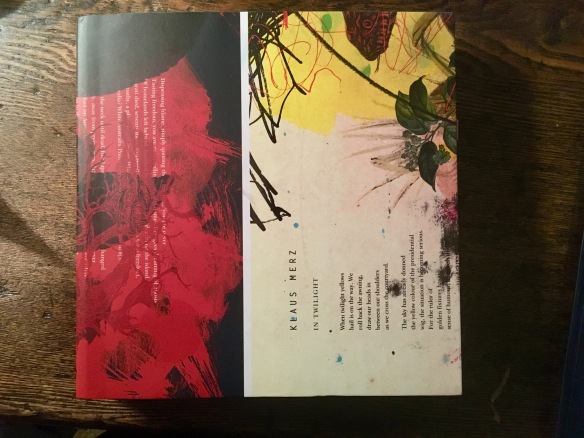
Seagull Annual Catalogue 2017-2018
Regular readers of this blog will know of my profound respect for publisher, Seagull Books. One of the year’s thrills is receiving Seagull Books’s elegant annual catalogue. The beautiful 2017-2018 edition includes my brief response to Naveen Kishore’s “provocation” (in italics):
“It begins slowly. Always in slow motion. With just the right pink and gold that the light designer ordered for the occasion. The script as perfect as can be. The director’s genius about to be rewarded. The performance about to, yes, begin. The curtain to rise. An audience seated. Resigned to what they know will unfold. Without change. Like having seen it happen before. Not here. Not at this particular venue. Or at this play. In their lives. They know the drama. The realism. The script. The dance. The moves. They know. Everything.
Drop a bomb. Set off a device. Blow to smithereens. Unless you do. The image that springs to mind when you see a ruin is gentle. Floating into the mind. Sideways. Almost horizontal. A sense of having fallen into something slowly. Over time. Perhaps what you labeled love. Like leaves. The kind that autumn sheds. Those. Very. Leaves. I guess things fall into gentle ruin. They do. That is the phrase I seek. The familiarity of the tragic. The kind that is foretold in every gesture you create. For yes. It is creative. This ruination. How else would it ever have got to the stage it has. One of utter helplessness. Descending into an aesthetically designed. Even overwhelming. Futility.
Embraces like coagulated clots growing. Thickening. Clinging walls. Solidifying layers settling. In an intense and congealed setting for decay to blossom. Into? Dare I say it? Decay. Decay yet to be born so unborn decay. The kind that waits. Waiting to grow. Flourish. Thrive. Open. Unfolding decay. One that matures into full blown decay. Without containment or known boundaries. Therefore spreading. This decay. Decay as epidemic. A decay of ruination. Utter and complete. Defeated decay. Gnawing at the foundations. Of what? Of what once. Was. Eroding decay. Relentless and unceasing. And yes. A committed decay.”
All things are in time, transient, and subject to change. Is it possible to conceive an entity without the potential for change? Is not the capacity for change a definitive element of a thing’s existence? For a thing to be incapable of change it surely must lie outside of time, what Samuel Beckett’s Molloy describes as the ‘indestructible chaos of timeless things”. To be in time is to be defined by terms like ‘past,’ ‘present,’ ‘future,’ ‘before,’ ‘after,’ and more nuanced terms like ‘simultaneous,’ ‘later,’ ‘always,’ and ‘forever,’ etc. Thus, for instance, if the Christian God is outside of time, to say that God existed before Moses is either false or meaningless. Does this suggest that time is illusory, unreal perhaps?
Whatever terms we use to cope with this sense of the unreal, all that is available to us is a succession of temporal moments; a progression of nows that comprise our immediate experience. To register our transience we reduce time to a series of clock or calendar measurements. Eliot’s Four Quartets draw together the poet’s reading of both eastern and western traditions to explore the ‘timeless moment’–assuming such a concept is not too problematic–when consciousness rubs up against deeper arrangements of meaning and order rooted in the substance of existence. In the final part of poem, Little Gidding, Eliot writes ‘A people without history / Is not redeemed from time, for history is a pattern / Of timeless moments.’ By indicating a way beyond the chaos of historical process as we normally receive it, Eliot suggests conditions that might make possible a redemptive transfiguration of self.
As we survey the ruins of self that is the aftermath of the modern consumerist obsession with finding a true identity, usually requiring some notion of fulfilment with consumption. Are we perhaps finally turning inward, away from self-absorbed individualism, a counter-reaction to an accelerated external world in which time has become ephemeral and fleeting?
Virginia Woolf, ahead of time in so many ways, wrote a haunting and intense story, The Fascination of the Pool, in which she uses a pond as metaphor for our consciousness. Its central theme is the interplay of water, light, past and future; its action invokes the submergence of our consciousness in its timeless reality. Modern science and its conception of water’s information structure as capable of possessing memories for the longest of times offers the tantalising possibility that human thought and emotion from the oldest times are both transient and timeless.
Sometimes I like to conceive of time as like water flowing in a river that always flows in the same direction. I can dream myself onto the river bank, outside of time’s flow, watching the whole span of earthly time as its memorised sequence of events flows by.

Thank you! Your gorgeous contribution was the first I read. Seagull have compiled so much wonderful content in this edition. So elegant too.
‘The ruins of self that is the aftermath of the modern consumerist obsession with finding a true identity’ – thought-provoking, at so many levels. Good read. I like the way you ended it.
Thank you, much appreciated.
I’m daunted by the number of Seagull titles I’d like to read – & by my ignorance of so many of them. Lovely post
Thank you. One could spend a happy lifetime reading Seagull.
Pingback: Ruins in Motion: My Essay for the 2017-2018 Seagull Books Catalogue |
Congratulations on the publication. The suggestion about water’s ability to hold memories is quite wonderful. I will be thinking about that image/concept for some time…
Thank you for taking the time to leave your comments, very much appreciated.